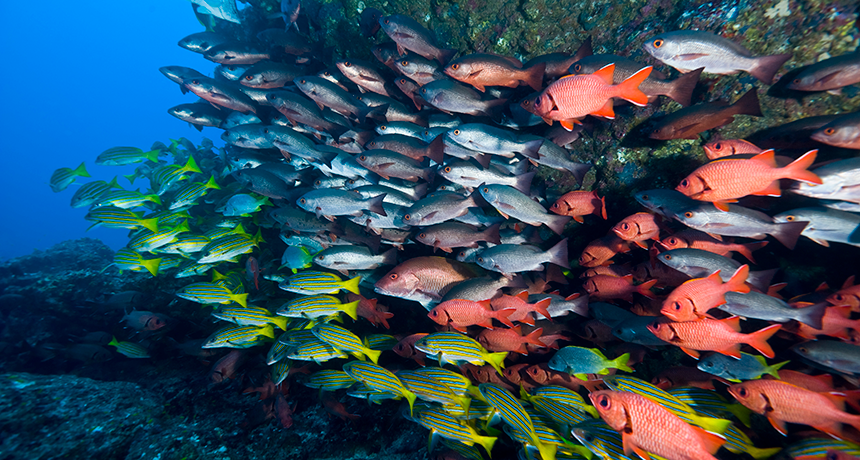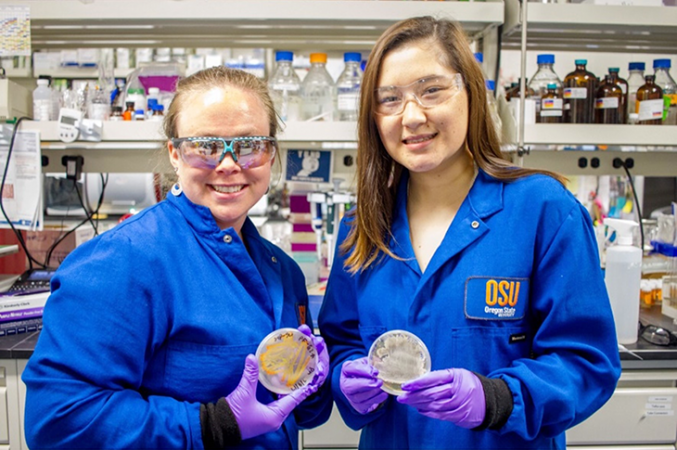Slimy fish could aid the search for new drugs
Their protective coating is chock-full of bacteria — and maybe antibiotics

Researchers are studying the bacteria that live on fish in the Pacific Ocean in search of molecules that could be turned into drugs.
strmko/iStock/Getty Images Plus
ORLANDO, Fla. — If you’ve ever tried to hold a fish, you know how slippery they are. Their slick, slimy coating doesn’t just help them wriggle away from you. It also helps protect them against tiny threats like germs. Now scientists are searching that fish slime for molecules that might one day help protect people against infections, too.
Sandra Loesgen is a chemist at Oregon State University in Corvallis. Her research aims to find new antibiotic drugs for people. That’s important because many disease-causing microbes no longer respond to current drugs.
One of Loesgen’s colleagues, Erin (Misty) Paig-Tran, got her interested in fish. Paig-Tran is a marine biologist at California State University in Fullerton. Paig-Tran wondered if something in fish slime — especially on young, growing fish — might help protect them in the harsh environment of the sea. Many researchers have looked in the ocean for new drugs, but not many have looked at the bacteria that live on fish. Together, Paig-Tran and Loesgen decided to scout for bacteria living in the slime.
Paig-Tran sent Loesgen swabs of slime from 17 species of juvenile fish. Two students on Loesgen’s team searched the goo for bacteria that might help the fish.
Molly Austin is an undergraduate researcher and Paige Mandelare is a graduate student. They smeared the slimy swabs on petri dishes. These held a gel-like substance, called agar, and nutrients that bacteria can eat. Then the students waited to see if the bacteria from the slime would grow.
They did. And as they grew, each type looked slightly different. Some grew as blue-green streaks across a dish of agar. Others looked like orange splotches. The researchers also used a microscope to look at each microbe’s size and shape. Austin and Mandelare then used these features to classify each type of bacteria. In total, they found 47 different types in the sampled slime.

Germs fighting germs
Next, Austin tested the bacteria to see if they might be useful for killing human pathogens (PATH-oh-jenz) — germs that cause disease. A surprising number of those bacteria she tested — about half — helped fight a pathogen called MRSA. (That’s short for methicillin-resistant Staphylococcus aureus.) MRSA can cause a serious infection because it is tough to treat. Many common antibiotic drugs do not kill it.
Five strains (or types) of bacteria from a pink surfperch seemed especially good at killing MRSA.
Austin studied one such strain more closely. She wanted to figure out how it might tackle the dangerous germ. It makes molecules called phenazines (FEN-uh-zeenz), she found. And these can kill other bacteria. Some scientists think phenazines might be useful as human drugs.
Loesgen’s team presented this work here at the spring national meeting of the American Chemical Society on March 31.
Next, her team wants to know if those phenazine-making bacteria normally live on pink surfperch. (The one Austin found could have just hitched a ride — what Loesgen calls a “one-hit wonder.”) The lab just got 10 more pink surfperch. If those fish also harbor the same strain, that may mean that it plays an important role in their slime ecosystem. And if the strain is there, the researchers will check if it makes phenazines on those fish, too.
Roger Linington is a chemist at Simon Fraser University in Vancouver, Canada. He studies bacterial communities inside fish, such as in their guts. The microbes in many fish species have not yet been explored, he notes. Loesgen’s approach of looking at slime from young fish is very thoughtful, he says.
Linington was not surprised that Loesgen’s group found so many microbes in the fish slime. “We know that niche environments often harbor a surprising array of different microorganisms,” he says. And finding even one MRSA-killing strain is “a very good result.”
There’s a lot we still don’t know about how microbes affect the health of their hosts, whether human or fish. But fish-dwelling bacteria may prove a promising source of new antibiotics, Loesgen says. So far, they’ve been overlooked, she adds. “We need to have much more effort in that area to isolate the bacteria and understand their function.”
So far, the team has only found well-known bacteria and molecules. But as they explore more types of bacteria in the slime, Loesgen hopes to turn up something new and useful.







